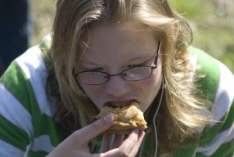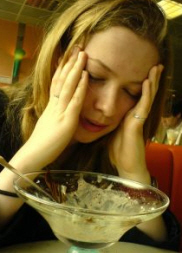 Anorexia nervosa is an eating disorder that affects mostly girls and women with the majority in their teens and early twenties when it develops. With strong therapy and long-term programs many of these girls have a chance of recovering from this psychological disorder that drives them to become thinner and thinner while not recognizing the effects on their bodies or having a strong realistic view of their body image.
Anorexia nervosa is an eating disorder that affects mostly girls and women with the majority in their teens and early twenties when it develops. With strong therapy and long-term programs many of these girls have a chance of recovering from this psychological disorder that drives them to become thinner and thinner while not recognizing the effects on their bodies or having a strong realistic view of their body image.
There are many after effects of anorexia that they may experience. Since growth and development of the bones and muscles happen throughout adolescence there may be serious long-term damage to the bone structures. It’s been estimated that osteopenia (low bone mass) happens in 90% of all patients with anorexia nervosa and 40% will suffer from osteroporosis.
Boys who are affected by anorexia nervosa may also suffer from stunted growth. Oftentimes boys are misdiagnosed since the majority of the people with anorexia are women. Delay in treatment of these boys can lead to greater issues with osteopenia from lack of calcium in the diet, poor weight gain, and short stature.
After diagnosis and treatment of anorexia many women continue to have difficulty with ovulation and menstruation. Although many will have return of normal fertility several years after returning to normal weight and normal eating patterns.
 Women with anorexia can suffer from neurological damage from the lack of nutrition. The heart and other organs are at risk for abnormalities. Electrolyte imbalances are not uncommon as well as anemia from the lack of nutrition. Long-term mood swings and psychological issues such as depression are not uncommon.
Women with anorexia can suffer from neurological damage from the lack of nutrition. The heart and other organs are at risk for abnormalities. Electrolyte imbalances are not uncommon as well as anemia from the lack of nutrition. Long-term mood swings and psychological issues such as depression are not uncommon.
The complications of anorexia are felt not only by the sufferer but also the family and friends of the person diagnosed with anorexia. A long readjustment period may be necessary while family members learn to trust that the sufferer is learning to eat appropriately and will no longer abuse their bodies. Not only will the readjustment period for the family be long but also the person experiencing this psychological disorder will find that it can take years to readjust their body image and their eating habits to something that resembles normalcy.
Once a person has starved their body for months, if not years, it may initially rebel with the added amount of food. This can result in bloating from a digestive system that is readjusting to being back to normal. Digestive enzymes must readjust and resume normal production as well as blood flow to the digestive system be reestablished at a normal level.
Women and men who were formerly anorexic can also have dental issues from the lack of calcium and other nutrients that are essential to build and maintain strong healthy teeth. Many believe that because they aren’t bulimic, or vomiting to rid themselves of food, that the teeth won’t become damaged. But, like all other parts of the body which require nutrition, the teeth depend upon what is fed to the body to remain healthy.
The complications of anorexia nervosa are less in people who receive early intervention, before major damage is done to the organ systems of the body. The strain of this eating disorder puts a strain and toll on the body functions that are both physical and psychological. Bodies begin to act in much the same way an older person’s body would act causing repair and growth to be slower.
Resources:
University of Maryland Medical Center: Eating Disorders
http://umm.edu/health/medical/reports/articles/eating-disorders
MayoClinic: Anorexia Nervosa
http://www.mayoclinic.com/health/anorexia/DS00606/DSECTION=complications
SomethingFishy: Physical Dangers and Effects of an Eating Disorder
http://www.something-fishy.org/dangers/dangers.php
Western Journal of Medicine: Medical Complications Occurring in Adolescents with Anorexia Nervosa
http://www.ncbi.nlm.nih.gov/pmc/articles/PMC1070803/
NHS: Anorexia Nervosa Complications
http://www.nhs.uk/Conditions/Anorexia-nervosa/Pages/Complications.aspx
Ohio State University Wexnes Medical Center: Anorexia Nervosa
HealthCentral: Eating Disorders
http://www.healthcentral.com/ency/408/guides/000049_5.html


Leave a Reply